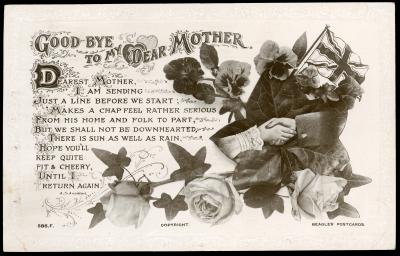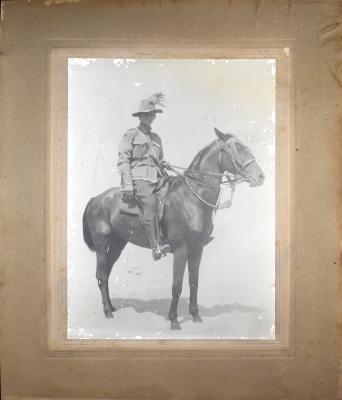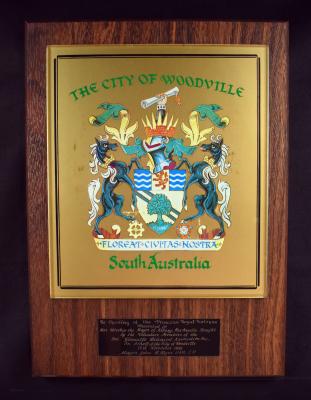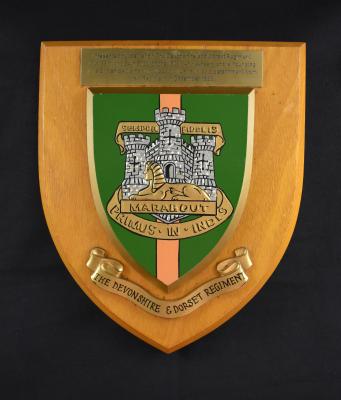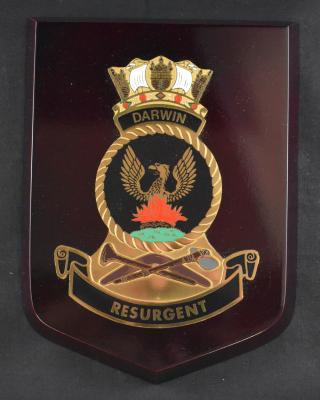Framed Photographic Postcards of Three French Transatlantic Liners at Le Havre France - Herbert Thomas HOWSON
c. 1920Oblong wooden frame displaying horizontally three black and white postcards of transatlantic liners at Le Havre Port France. The frame is made of a dark wood and the cards are displayed on a dark wooden board behind glass. The rear of the frame is in good condition and shows the nails used to hold the back board in place together with the remnants of brown tape used to seal the back board. The frame was hung using gold coloured metal wire with a metal eye hook at each end. These hooks show signs of rust. Each of the three liners is pictured from the side at sail in Le Havre. All three are flying the flag of the shipping line CGT, together with French and at least one American flag. Steam can be seen from each of the liners smokestacks and there is a small tugboat alongside the liner “France”.
All 3 liners pictured on the postcards sailed for the Compagnie Générale Transatlantique (CGT), typically known overseas as the French Line, a French shipping company that has its origins in 1861. During the First World War thirty-seven ships (two-fifths of the fleet) were requisitioned. The company designated a number of its large liners to serve as auxiliary cruisers and SS La Savoie and SS La Touraine, were requisitioned at the start of the war to ensure the blockade of Germany.
La Lorraine was a French steamship built in 1899 as part of a pair with La Savoie. In the early 1900s she served as a passenger liner between Le Havre and New York until August 1914 when she was converted for troop transport as an auxiliary cruiser. She was renamed Lorraine ll. Beginning 1916 she was used with her sister La Savoie, as a trooper, bringing 46.000 Serbian soldiers from Corfu to Thessaloniki. In September 1917 she was decommissioned by the French Navy and renamed back to La Lorraine. She returned to the Le Havre New York route in 1919 and was scrapped in December 1922.
La Savoie is the younger identical sister vessel to La Lorraine. La Savoie started her North Atlantic career on 31 August 1901 with her inaugural crossing to New York. La Savoie´s last crossing started July 18 1914 after which, she was the commissioned by the French Navy and converted into an auxiliary cruiser, In January 1915 she was transferred to the French Mediterranean Fleet, where she participated in the Gallipoli Campaign. She disembarked troops at the Dardanelles and in the Eastern Mediterranean. On one of these transports, she was hit by a Turkish coast battery. At the beginning of 1916 La Savoie and La Lorraine were part of the fleet which brought Serbian troops from Corfu to Thessaloniki and from 1917 onwards she was part of the troop transport fleet from the USA to Europe.
After Armistice and the end of the hostilities La Savoie was converted back into her former role as transatlantic liner. On 25 September 1927 La Savoie sailed for the last time to New York after which, on 25 November 1927, she sailed for Dunkerque, where she was scrapped.
The SS France was a French transatlantic liner. When war broke out in 1914 she was immediately requisitioned by the French Navy for use as an armed merchant cruiser and renamed France IV. Her time as a cruiser was short-lived as she was too large and burned too much coal to be of good use and was consequently reconfigured to carry troops. On 18 June 1916, the France was involved in a collision with the British destroyer HMS Eden in the English Channel. Eden sank with the loss of 43 officers and men, including her commander, with the France rescuing the remaining 33 survivors. Later that year, she was painted white and used as a hospital ship in the Dardanelles, converted to accommodate 2,500 injured troops. She continued in this role until 1917, when she was deployed back to the Atlantic to ferry American troops to the continent with space for some 5,000 individuals. In 1918, her military service was cut short by an engine room explosion that killed nine crew members and required extensive repairs. After the war she returned to passenger service. She was scrapped in 1935.
The postcards were framed by Private Herbert Thomas HOWSON service number 3150 who enlisted on 21July 1915 and embarked for France on the HMAT Medic on 18 January 1916. Herbert was from Fremantle and was aged 22 when he enlisted. He served in France and was wounded in 1916 in the jaw. He returned to France for the remainder of the war was repatriated to Australia in April 1919.
Details
Details
Taken from the Right as the postcards are viewed:
Post Card 1: “C.V. - 12. - LE HAVRE. - L’Avant-Port et le Transatlantique La Lorraine”
Post Card 2 : “C.V. - 25. - LE HAVRE. – Le Transatlantique France / Longueur, 218 metres ; largeur, 23 metres ; jaugeant 27,000 tonnes ; 4 helices actionnees par des turbines ; vitesse, 23 noeuds / L’appareil evaporatoire se compose de 4 cheminees, 120 foyers, les cheminees de forme elliptique ont 34m de hauteur, 5m 30 au / grand axe,4m10au au petit. Passagers, 2000.”
Post Card 3 : “C.V. - 13. - LE HAVRE. – Le Transatlantique La Savoie"
Open in Google Maps
Nearest geotagged records:
- Invalid Cup (0km away)
- Peter Loney Letter (0km away)
- Ellis SILAS Water Colour Painting (0km away)
- Engraved Japanese Water Bottle belonging to Robert George Staunton RENNIE WX7493 (0km away)
- Enlistment Poster (0km away)
- W. D. & H. O. Wills Lace Flag Cigarette Cards (0km away)
- First world War Picture Postcard (0km away)
- Photograph of the Japanese surrender to Australia on 13 September 1945. (0km away)
- Engraved Tin given to Major Arthur Robinson HOME WX11151 (0km away)
- Martini-Henry action (0km away)
Nearby places: View all geotagged records »
Princess Royal Fortress Military Museum
Princess Royal Fortress Military Museum
Other items by Herbert Howson
Other items from Princess Royal Fortress Military Museum
- Four Framed Photographic Postcards of Le Havre Port France - Herbert Thomas HOWSON
- SS Orvieto Brass Ashtray
- First World War “Good Bye to my Dear Mother” Postcard from Private William Dobson STEVENS 4002
- Black and white photographic postcard of Trooper Henry RISEBOROUGH on his mount ‘Gus’
- City of Woodville Plaque
- Princess Royal Fortress (The Forts) Plaque
- Princess Royal Fortress (The Forts) Re-opening Plaque
- Western Australian Tourism Commission Plaque
- The Devonshire and Dorset Regiment Plaque
- America's Signal Lookout Plaque
- HMAS Sirius Plaque
- HMAS Darwin Plaque


